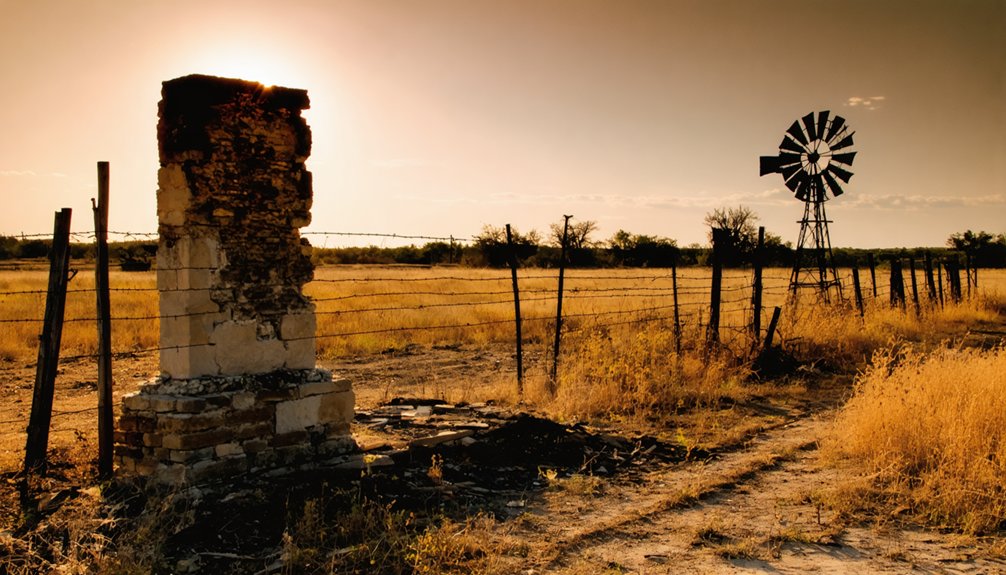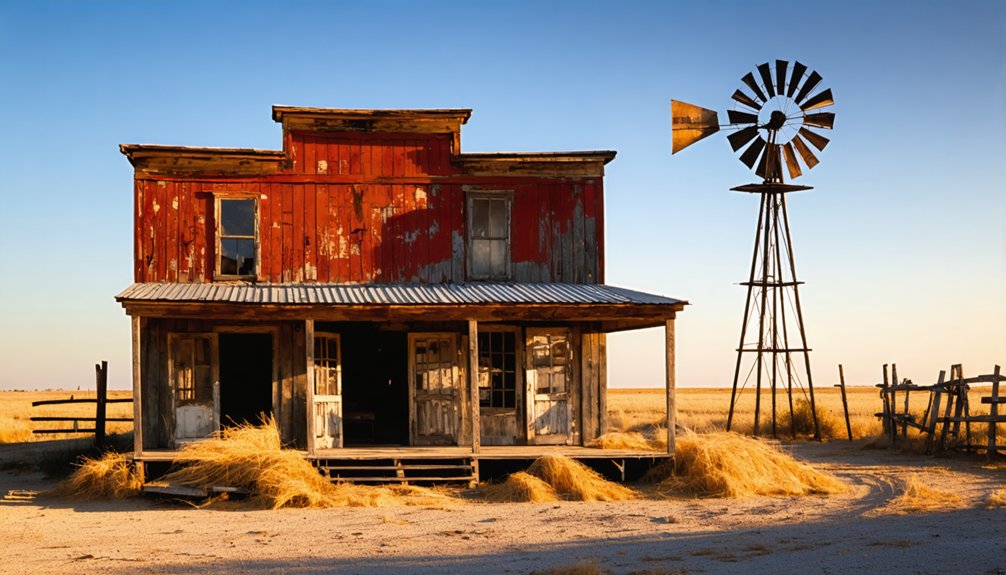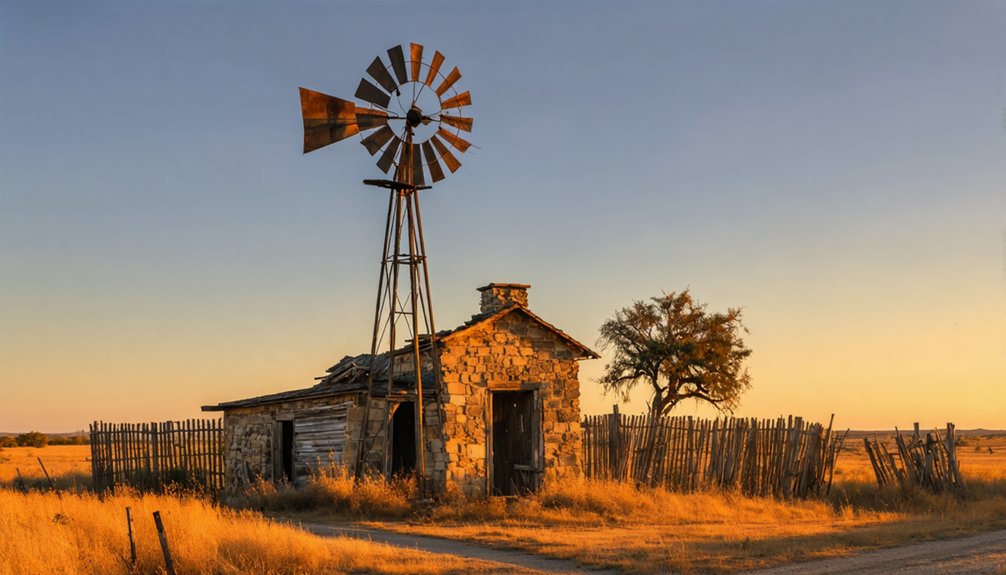You’ll find Hayrick’s ghost town remains beneath its namesake 2,616-foot mountain in Coke County, Texas. This frontier settlement, established in 1889 as the county’s first seat, thrived briefly with 163 farms and essential services before political rivalries sparked courthouse arsons. After losing a contentious 48-vote election to Robert Lee in 1891, Hayrick rapidly declined. Today, only a cemetery and historical marker hint at the dramatic tale of power, sabotage, and frontier ambition.
Key Takeaways
- Hayrick was established in the late 1880s near its namesake Hayrick Mountain, becoming Coke County’s first seat in 1889.
- Political disputes and courthouse arsons contributed to Hayrick losing its county seat status to Robert Lee in 1891.
- Water scarcity and resource limitations ultimately led to the town’s abandonment, leaving only a cemetery and historical marker today.
- The ghost town’s site preserves graves of early settlers beneath Hayrick Mountain, which stands 2,616 feet high.
- The town’s brief existence from 1889-1891 as county seat ended after a contentious 48-vote election favoring Robert Lee.
A Mountain Shapes a Town’s Identity
While many Texas towns grew organically around rivers or railroads, Hayrick’s identity emerged from the distinctive profile of Hayrick Mountain, a 2,616-foot elevation that dominates southeastern Coke County’s landscape.
Rising 2,616 feet above Coke County, Hayrick Mountain’s distinctive silhouette birthed both a town’s name and its identity.
You’ll notice how the mountain’s haystack-like shape directly influenced the town’s naming, creating a unique geographic identity that set it apart from other settlements in the region. To prevent confusion with other similarly-named locations, the town required identity verification from postal authorities.
The mountain’s influence extended beyond mere naming – it served as a vital landmark for early settlers and travelers, helping them navigate the Texas terrain.
As you explore the area today, you’ll find that the mountain’s moderately steep slopes and high local relief shaped everything from settlement patterns to farming practices, becoming an integral part of the community’s character before Hayrick became a ghost town. By 1890, the area supported 163 farms despite the challenging terrain.
Early Settlement and Community Growth
When pioneer families first settled around Hayrick Mountain in the late 1880s, they’d found a promising location for ranching and homesteading in southeastern Coke County, Texas.
By 1887, you’d have seen about 25 residents establishing themselves near the distinctive mountain that gave the community its name. Like the silver mining operations that would later shape Shafter’s destiny, these early settlers were drawn by the potential of the land’s natural resources. Similar to the town of Old Alton Bridge, only remnants of the original settlement survive today.
The settlement’s growth centered on a newly established post office that served as a crucial connection point for the isolated ranching families who’d made this rugged terrain their home.
Pioneer Families Arrive 1887
In 1887, approximately twenty-five pioneer settlers established the community of Hayrick, Texas, choosing land near a distinctive hay-shaped hill that inspired the town’s name.
Pioneer migration patterns brought diverse families like the French-descended Recks, who joined others from Tennessee and Illinois seeking opportunities on the open plains. Like many Texas settlers in that era, Milton Damron traveled from Tennessee to establish roots in new territory. You’ll find these early homesteaders faced significant challenges, particularly with insufficient water supplies that threatened their settlement’s sustainability. The journey to new settlements often required ten days by wagon, as experienced by pioneers like John Reck traveling to nearby Claude.
The great buffalo hunt of 1887 cleared the way for ranching operations, and you’ll see how families adapted by establishing sheep ranches and cattle operations.
They’d soon shift from open range to fenced properties, while building lasting community institutions. By 1890, they’d founded the Hayrick Masonic Lodge No. 696, strengthening social bonds among these determined pioneers.
Establishing Local Post Office
The establishment of Hayrick’s post office on August 6, 1889, marked a pivotal shift from isolated frontier settlement to organized village.
You’ll find that this federal service, initially housed in James A. Waldrop’s home near Buck Mountain, didn’t begin operations until February 9, 1891, when Hubert H. Pearce took charge as the first postmaster. Like many early Texas post offices, the service faced financial revenue struggles that impacted its operations and growth.
Similar to the practice at Over The River post office, mail service operated from private residences to serve the community efficiently.
The post office significance extended far beyond mail delivery. As an essential communication link, it connected you with the outside world, encouraging trade and settlement in this remote region.
You’d have found the post office instrumental in Hayrick’s brief tenure as county seat from 1889 to 1890. Operating from private homes, as was common in frontier Texas, the postal service integrated seamlessly with the local economy while maintaining critical connections to regional mail routes.
Life Around Hayrick Mountain
Drawn by vast open grazing lands surrounding Hayrick Mountain, pioneering ranchers established the first permanent settlements in the area between 1860 and the early 1880s.
You’d find J.J. Austin’s ranch headquarters near Sanco by 1875, while Pate Francher drove cattle herds to nearby ranches two years later. Despite settlement challenges like severe drought and fence-cutting disputes in the 1880s, the community’s resilience prevailed. The Fort Chadbourne site had previously served as a U.S. Army frontier protection post until the Civil War. The barbed wire wars erupted as ranchers attempted to enclose their newly claimed homesteads.
By 1890, you could count 163 farms and ranches supporting 2,059 residents. Ranch headquarters served as essential community centers, while four schools and the county’s first newspaper, the Hayrick Democrat, fostered social connections.
Though water scarcity eventually forced relocation of the county seat to Robert Lee, the area’s agricultural legacy lived on through extensive cattle and sheep operations.
Rise to County Seat Status
After the Texas Legislature carved Coke County from Tom Green County on April 23, 1889, the small settlement of Hayrick quickly rose to prominence as the county’s first seat of government. Named for a distinctive hill resembling a hay mound, this frontier town of twenty-five settlers established the foundations of local governance, complete with a log courthouse and the county’s first newspaper, the *Hayrick Democrat*.
Hayrick’s governance centered around a modest courthouse that served as the hub for administrative functions and county records. While the town developed essential institutions like schools to support its role, it faced fierce opposition from southern county residents.
Water scarcity proved to be Hayrick’s greatest challenge, leading to violent protests including two courthouse arsons that destroyed crucial records.
Mystery of the Burning Courthouses

You’ll find a web of intrigue surrounding Hayrick’s courthouse fires of 1890, where most county records were destroyed amid accusations of misappropriated filing fees from homesteaders.
The plot thickens with the suspicious death of lawyer Billups, who was found drowned in a shallow creek while investigating the remaining records, his body discovered with a heavy rock wired to his neck and his feet bound together.
These events accelerated Hayrick’s decline as county seat, ultimately contributing to the successful campaign to relocate administrative powers to Robert Lee in 1891.
Suspicious Fires and Deaths
During Hayrick’s brief tenure as the Coke County seat, a series of suspicious fires devastated the town’s courthouses and surrounding buildings, ultimately contributing to its demise.
While fire investigations never identified the culprits, local lore points to arson tied to heated disputes over the county seat’s location.
You’ll find that two log courthouses burned to the ground, followed by fires at temporary facilities where officials had relocated records.
The timing wasn’t coincidental – the first courthouse burned just before the 1891 county seat election, which Hayrick lost to Robert Lee by 48 votes.
Southern Coke County settlers who opposed Hayrick’s position as county seat were suspected, though no proof was ever found.
Today, only ghostly sightings and a cemetery remain of this once-promising frontier town.
Political Motivations Behind Arson
The suspicious fires that plagued Hayrick’s courthouses stemmed from deep-rooted political tensions over the county seat’s location.
You’ll find that arson tactics became a deliberate form of political sabotage, as opponents sought to undermine Hayrick’s legitimacy as the county seat. When fires destroyed two log courthouses, they didn’t just burn buildings – they eliminated essential records and disrupted local governance.
The stakes were high in 1891 when Robert Lee won the county seat election by just 48 votes.
Large ranchers had offered free lots to encourage residents to move south, while political factions orchestrated the courthouse burnings to force relocation.
These calculated acts of destruction ultimately succeeded, as the loss of records and administrative capabilities helped shift power away from Hayrick and secured Robert Lee’s position as the new county seat.
The Contentious Election Battle
While Hayrick served as Coke County’s original seat of government in 1889, growing dissatisfaction among southern settlers sparked a fierce political battle by 1891.
The election strategies centered on two county judge candidates: H. L. Adams, who championed a special election for relocating the county seat, and incumbent G. W. Perryman, who opposed the move.
After Adams’ victory, the stage was set for a decisive showdown between Hayrick and Robert Lee.
Adams’ triumph ignited the inevitable clash between rival towns Hayrick and Robert Lee for control of county leadership.
With a voter turnout of approximately 400 people, Robert Lee emerged victorious by a slim 48-vote margin.
The outcome triggered immediate demographic shifts as families relocated to the new county seat, aided by prominent ranchers offering free lots to encourage settlement.
You can trace Hayrick’s decline directly to this pivotal election.
From Thriving Hub to Abandonment

Following the decisive 1891 election, Hayrick’s transformation from a bustling frontier hub to an abandoned settlement happened swiftly and dramatically.
You’d have witnessed entire families packing up their belongings and relocating to Robert Lee, fundamentally altering the community dynamics that had defined Hayrick’s early years.
The town’s economic decline accelerated as businesses shuttered and administrative functions moved to the new county seat.
Making matters worse, two suspicious courthouse fires destroyed crucial records, further destabilizing the remaining population.
When a local lawyer investigating possible financial misconduct was found dead under questionable circumstances, it dealt another blow to the town’s survival prospects.
Within a short time, Hayrick’s once-promising future had vanished, leaving only its cemetery and the distinctive mountain that gave it its name.
Legacy in the Texas Landscape
Modern visitors to Hayrick’s former site will find only its historic cemetery and a solitary historical marker as evidence to this once-promising frontier settlement.
You’ll discover headstones dating back to the town’s founding settlers, preserving essential demographic data that tells the story of early Texas frontier life.
While the physical town has vanished, cultural preservation efforts keep Hayrick’s memory alive through oral histories and archived testimonies from descendants.
Local heritage groups document the ghost town’s turbulent past, including courthouse arsons and political disputes that shaped Coke County’s development.
The site’s transformation represents a familiar pattern in Texas history, where administrative decisions and regional politics determined which frontier settlements would thrive and which would fade into memory.
Frequently Asked Questions
What Happened to the Lawyer Who Drowned While Investigating the Fires?
Like a case gone cold, you’ll find the lawyer’s investigation ended in tragedy when they drowned while probing fires in Texas. The exact details surrounding this drowning mystery remain largely undocumented.
Are There Any Descendants of Original Hayrick Settlers Still Living Nearby?
While you’ll find descendant stories suggesting local connections persist, there’s no confirmed documentation of original Hayrick settlers’ descendants living nearby – though many families likely settled in Robert Lee after 1891.
Can Visitors Access the Hayrick Cemetery Grounds Today?
Like whispers from the past, you’ll find open cemetery access awaiting your visit, though ghost stories linger. You can freely explore these historic grounds without restrictions through public roads near Highway 158.
What Was the Exact Population of Hayrick at Its Peak?
You’ll find that Hayrick’s history records a peak population of approximately 150 residents during its brief reign as county seat in the late 1880s, before its dramatic population decline began.
Were Any Artifacts From the Original Courthouses Ever Recovered?
Like flames consuming history’s pages, you won’t find any surviving artifacts from Hayrick’s original courthouses. Two devastating fires – first at Hayrick, then at Robert Lee – destroyed nearly all courthouse records and materials.
References
- http://siouxsue.blogspot.com/2010/12/another-texas-ghost-town-hayrick-texas.html
- http://files.usgwarchives.net/tx/coke/newspapers/history/oralhist.txt
- https://en.wikipedia.org/wiki/List_of_ghost_towns_in_Texas
- https://www.geocaching.com/geocache/GCX0HY
- https://www.tshaonline.org/handbook/entries/hayrick-tx
- https://www.tshaonline.org/handbook/entries/sanco-tx
- https://texashistory.unt.edu/explore/locations/p18126/
- https://www.texasescapes.com/TexasTowns/Hayrick-Texas.htm
- https://pubs.usgs.gov/bul/0190/report.pdf
- https://www.tshaonline.org/handbook/entries/hayrick-mountain



